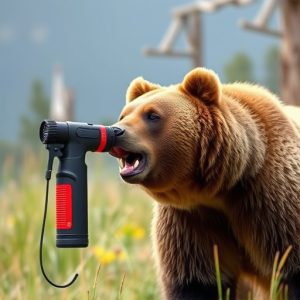Optimize Bear Spray Safety: Mastering Wind Direction and Preventive Tips
Understanding wind direction is paramount for maximizing the effectiveness of bear spray, a crucial…….
Understanding wind direction is paramount for maximizing the effectiveness of bear spray, a crucial safety tool in bear-inhabited areas. Users must spray into the wind to ensure particles reach the bear's face and eyes, temporarily disorienting it. Proper deployment techniques, regular training, and keeping bear spray readily accessible are essential safety tips to enhance encounters with bears.
In areas inhabited by bears, knowing how to prevent and respond to attacks is crucial. One effective tool in many survival kits is bear spray—a potent chemical deterrent designed to deter aggressive bears. Understanding its composition and effectiveness, mastering wind direction for optimal protection, and following safety tips for efficient use are essential skills for anyone adventuring outdoors in bear country. This guide covers these aspects, empowering folks with knowledge to enhance their safety.
- Understanding Bear Spray: Composition and Effectiveness
- Mastering Wind Direction for Optimal Protection
- Essential Safety Tips for Efficient Use and Prevention
Understanding Bear Spray: Composition and Effectiveness
Bear spray, also known as bear repellent, is a crucial tool for outdoor enthusiasts navigating regions with bear populations. Understanding its composition and effectiveness is key to ensuring safety tips are followed when hiking or camping in bear country. Typically, bear spray contains capsaicin, the active ingredient found in chili peppers, along with other chemicals designed to deter bears. When sprayed, it creates an irritant barrier, temporarily blinding and disorienting the bear, allowing the user time to escape or defend themselves.
The wind direction plays a significant role in the effectiveness of bear spray. It’s recommended to always spray towards the bearing wind, as the particles will then land on the bear’s face and eyes, causing maximum irritation. Conversely, spraying against the wind may result in the spray returning to the user. Safety tips also include keeping the spray readily accessible, practicing proper usage techniques, and being aware that no single method guarantees 100% protection against bear attacks.
Mastering Wind Direction for Optimal Protection
Understanding wind direction is a vital safety tip when it comes to bear spray effectiveness. Since bear spray works by delivering a cloud of irritants into the bear’s eyes, nose, and respiratory system, aiming for direct impact is key. When you’re in grizzly country, take note of the wind’s direction before deploying your spray. If possible, position yourself downwind from the bear to ensure the spray reaches it directly. This simple step can significantly increase the chances of a successful deterrence, as the spray will act as a barrier, creating a safe distance between you and the potential aggressor.
For instance, if you’re hiking and spot a bear on the opposite side of a river, anticipate the wind’s flow. If it’s likely to blow from upstream (towards you) or be still, consider crossing to the other side for better protection. Mastering this skill allows hikers, campers, and outdoor enthusiasts to stay one step ahead in bear country, enhancing their safety during potential encounters.
Essential Safety Tips for Efficient Use and Prevention
When carrying bear spray, understanding the wind direction is crucial for efficient use and prevention. Always face into the wind when deploying the spray to ensure it reaches the bear directly. Misting away from your body allows for optimal coverage while minimizing exposure to yourself.
Regular training and familiarization with your bear spray are essential safety tips. Practice activating the spray in controlled environments to get a feel for its range and effectiveness. Remember, bear spray is most effective as a deterrent when used early during an encounter. Keep it readily accessible, and be prepared to deploy it quickly if needed.
Bear spray is a valuable tool for outdoor enthusiasts navigating bear country, but its effectiveness heavily depends on understanding wind direction and practicing safe application techniques. By mastering these key aspects, individuals can enhance their safety and reduce the risk of potential bear attacks. Remember, proper usage and knowledge of wind patterns are crucial components in ensuring your protection while exploring nature’s wild spaces.


